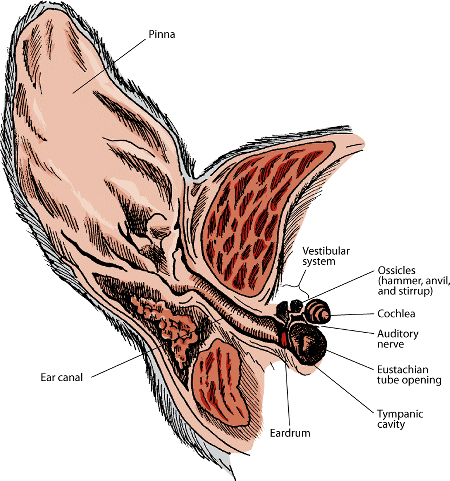Ear Structure and Function in Dogs
- Ear Disorders of Dogs
- Ear Structure and Function in Dogs
- Deafness in Dogs
- Disorders of the Outer Ear in Dogs
- Otitis Externa in Dogs
- Otitis Media and Interna in Dogs
- Tumors of the Ear Canal in Dogs
Also see professional content regarding ear structure of a dog.
The ear is an organ of hearing and an organ of balance. It consists of the outer, middle, and inner ear.
The outer ear includes the pinna (the part you see that is made of cartilage and covered by skin, fur, or hair) and the ear canal. The pinna is shaped to capture sound waves and funnel them through the ear canal to the eardrum. In dogs, the pinnae are mobile and can move independently of each other. The size and shape of the pinnae vary by breed. The ear canal of the dog is much deeper than that of people and creates a better funnel to carry sound to the eardrum. The average dog can hear about 4 times better than the average person, including sounds at higher frequencies than can be detected by the human ear.
The middle ear includes the eardrum and a small, air-filled chamber that contains 3 tiny bones: the hammer, anvil, and stirrup. It also includes 2 muscles, the oval window, and the eustachian tube (a small tube that connects the middle ear with the back of the nose, allowing air to enter the middle ear).
The inner ear is a complex structure that includes the cochlea (the organ of hearing) and the vestibular system (the organ of balance).
Physical Examination of the Ear
Infections of the ear and other ear disorders are common in dogs. Your veterinarian will examine your dog’s ears at every routine checkup. If the dog has a history of previous ear infections or other problems with the ear, you should provide that information to the veterinarian.
To start, your veterinarian will visually inspect the outer ears, noting any signs of inflammation, injury from trauma, swelling, secretions, or excessive ear wax. He or she will then use an instrument called an otoscope to view the ear canal and eardrum. In some cases, hair may need to be removed from the ear canals to allow the veterinarian a clear view of the ear drum.
If an infection is suspected, tests will be performed on samples of fluid or secretions from the ear to determine the organisms involved and the proper treatment. Infections in dogs are most commonly caused by bacteria or yeasts. Sometimes excessive overgrowth of tissue or the development of a tumor is seen.
To diagnose a tumor of the ear, it may be necessary to do a pinch biopsy for evaluation. This can usually be done using forceps and an otoscope. Further tests, including x-rays, neurologic tests, and electronic tests may be needed to confirm certain conditions such as deafness.
For More Information
Also see professional content regarding ear structure of a dog.
Resources In This Article
- Ear Disorders of Dogs
- Ear Structure and Function in Dogs
- Deafness in Dogs
- Disorders of the Outer Ear in Dogs
- Otitis Externa in Dogs
- Otitis Media and Interna in Dogs
- Tumors of the Ear Canal in Dogs






